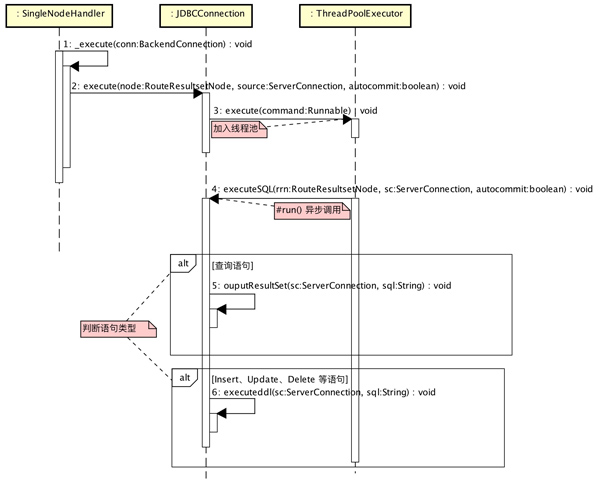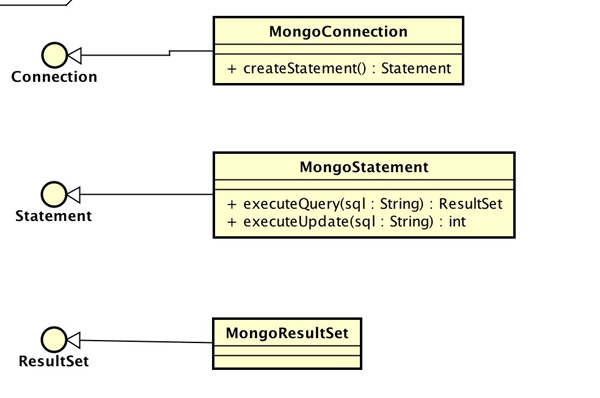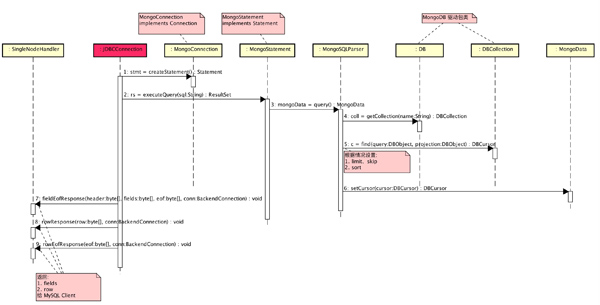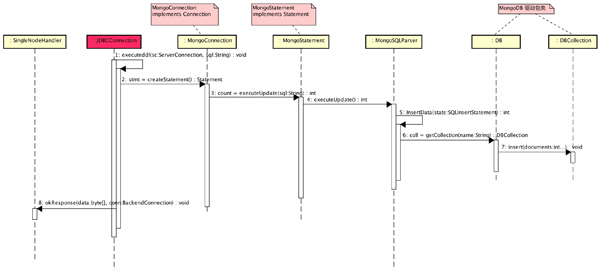1. 概述
可能你在看到这个标题会小小的吃惊,MyCAT 能使用 MongoDB 做数据节点。是的,没错,确实可以。
吼吼吼,让我们开启这段神奇的“旅途”。
本文主要分成四部分:
- 总体流程,让你有个整体的认识
- 查询操作
- 插入操作
- 彩蛋,😈彩蛋,🙂彩蛋
建议你看过这两篇文章(_非必须_):
2. 主流程
- MyCAT Server 接收 MySQL Client 基于 MySQL协议 的请求,翻译 SQL 成 MongoDB操作 发送给 MongoDB Server。
- MyCAT Server 接收 MongoDB Server 返回的 MongoDB数据,翻译成 MySQL数据结果 返回给 MySQL Client。
这样一看,MyCAT 连接 MongoDB 是不是少神奇一点列。
Java数据库连接,(Java Database Connectivity,简称JDBC)是Java语言中用来规范客户端程序如何来访问数据库的应用程序接口,提供了诸如查询和更新数据库中数据的方法。JDBC也是Sun Microsystems的商标。JDBC是面向关系型数据库的。
MyCAT 使用 JDBC 规范,抽象了对 MongoDB 的访问。通过这样的方式,MyCAT 也抽象了 SequoiaDB 的访问。可能这样说法有些抽象,看个类图压压惊。
是不是熟悉的味道。不得不说 JDBC 规范的精妙。
3. 查询操作
- SELECT id, name FROM user WHERE name > '' ORDER BY _id DESC;
看顺序图已经很方便的理解整体逻辑,我就不多废话啦。我们来看几个核心的代码逻辑。
1)、查询 MongoDB
- // MongoSQLParser.java
- public MongoData query() throws MongoSQLException {
- if (!(statement instanceof SQLSelectStatement)) {
- //return null;
- throw new IllegalArgumentException("not a query sql statement");
- }
- MongoData mongo = new MongoData();
- DBCursor c = null;
- SQLSelectStatement selectStmt = (SQLSelectStatement) statement;
- SQLSelectQuery sqlSelectQuery = selectStmt.getSelect().getQuery();
- int icount = 0;
- if (sqlSelectQuery instanceof MySqlSelectQueryBlock) {
- MySqlSelectQueryBlock mysqlSelectQuery = (MySqlSelectQueryBlock) selectStmt.getSelect().getQuery();
- BasicDBObject fields = new BasicDBObject();
- // 显示(返回)的字段
- for (SQLSelectItem item : mysqlSelectQuery.getSelectList()) {
- //System.out.println(item.toString());
- if (!(item.getExpr() instanceof SQLAllColumnExpr)) {
- if (item.getExpr() instanceof SQLAggregateExpr) {
- SQLAggregateExpr expr = (SQLAggregateExpr) item.getExpr();
- if (expr.getMethodName().equals("COUNT")) { // TODO 待读:count(*)
- icount = 1;
- mongo.setField(getExprFieldName(expr), Types.BIGINT);
- }
- fields.put(getExprFieldName(expr), 1);
- } else {
- fields.put(getFieldName(item), 1);
- }
- }
- }
- // 表名
- SQLTableSource table = mysqlSelectQuery.getFrom();
- DBCollection coll = this._db.getCollection(table.toString());
- mongo.setTable(table.toString());
- // WHERE
- SQLExpr expr = mysqlSelectQuery.getWhere();
- DBObject query = parserWhere(expr);
- // GROUP BY
- SQLSelectGroupByClause groupby = mysqlSelectQuery.getGroupBy();
- BasicDBObject gbkey = new BasicDBObject();
- if (groupby != null) {
- for (SQLExpr gbexpr : groupby.getItems()) {
- if (gbexpr instanceof SQLIdentifierExpr) {
- String name = ((SQLIdentifierExpr) gbexpr).getName();
- gbkey.put(name, Integer.valueOf(1));
- }
- }
- icount = 2;
- }
- // SKIP / LIMIT
- int limitoff = 0;
- int limitnum = 0;
- if (mysqlSelectQuery.getLimit() != null) {
- limitoff = getSQLExprToInt(mysqlSelectQuery.getLimit().getOffset());
- limitnum = getSQLExprToInt(mysqlSelectQuery.getLimit().getRowCount());
- }
- if (icount == 1) { // COUNT(*)
- mongo.setCount(coll.count(query));
- } else if (icount == 2) { // MapReduce
- BasicDBObject initial = new BasicDBObject();
- initial.put("num", 0);
- String reduce = "function (obj, prev) { " + " prev.num++}";
- mongo.setGrouyBy(coll.group(gbkey, query, initial, reduce));
- } else {
- if ((limitoff > 0) || (limitnum > 0)) {
- c = coll.find(query, fields).skip(limitoff).limit(limitnum);
- } else {
- c = coll.find(query, fields);
- }
- // order by
- SQLOrderBy orderby = mysqlSelectQuery.getOrderBy();
- if (orderby != null) {
- BasicDBObject order = new BasicDBObject();
- for (int i = 0; i < orderby.getItems().size(); i++) {
- SQLSelectOrderByItem orderitem = orderby.getItems().get(i);
- order.put(orderitem.getExpr().toString(), getSQLExprToAsc(orderitem.getType()));
- }
- c.sort(order);
- // System.out.println(order);
- }
- }
- mongo.setCursor(c);
- }
- return mongo;
- }
2)、查询条件
- // MongoSQLParser.java
- private void parserWhere(SQLExpr aexpr, BasicDBObject o) {
- if (aexpr instanceof SQLBinaryOpExpr) {
- SQLBinaryOpExpr expr = (SQLBinaryOpExpr) aexpr;
- SQLExpr exprL = expr.getLeft();
- if (!(exprL instanceof SQLBinaryOpExpr)) {
- if (expr.getOperator().getName().equals("=")) {
- o.put(exprL.toString(), getExpValue(expr.getRight()));
- } else {
- String op = "";
- if (expr.getOperator().getName().equals("<")) {
- op = "$lt";
- } else if (expr.getOperator().getName().equals("<=")) {
- op = "$lte";
- } else if (expr.getOperator().getName().equals(">")) {
- op = "$gt";
- } else if (expr.getOperator().getName().equals(">=")) {
- op = "$gte";
- } else if (expr.getOperator().getName().equals("!=")) {
- op = "$ne";
- } else if (expr.getOperator().getName().equals("<>")) {
- op = "$ne";
- }
- parserDBObject(o, exprL.toString(), op, getExpValue(expr.getRight()));
- }
- } else {
- if (expr.getOperator().getName().equals("AND")) {
- parserWhere(exprL, o);
- parserWhere(expr.getRight(), o);
- } else if (expr.getOperator().getName().equals("OR")) {
- orWhere(exprL, expr.getRight(), o);
- } else {
- throw new RuntimeException("Can't identify the operation of of where");
- }
- }
- }
- }
- private void orWhere(SQLExpr exprL, SQLExpr exprR, BasicDBObject ob) {
- BasicDBObject xo = new BasicDBObject();
- BasicDBObject yo = new BasicDBObject();
- parserWhere(exprL, xo);
- parserWhere(exprR, yo);
- ob.put("$or", new Object[]{xo, yo});
- }
3)、解析 MongoDB 数据
- // MongoResultSet.java
- public MongoResultSet(MongoData mongo, String schema) throws SQLException {
- this._cursor = mongo.getCursor();
- this._schema = schema;
- this._table = mongo.getTable();
- this.isSum = mongo.getCount() > 0;
- this._sum = mongo.getCount();
- this.isGroupBy = mongo.getType();
- if (this.isGroupBy) {
- dblist = mongo.getGrouyBys();
- this.isSum = true;
- }
- if (this._cursor != null) {
- select = _cursor.getKeysWanted().keySet().toArray(new String[0]);
- // 解析 fields
- if (this._cursor.hasNext()) {
- _cur = _cursor.next();
- if (_cur != null) {
- if (select.length == 0) {
- SetFields(_cur.keySet());
- }
- _row = 1;
- }
- }
- // 设置 fields 类型
- if (select.length == 0) {
- select = new String[]{"_id"};
- SetFieldType(true);
- } else {
- SetFieldType(false);
- }
- } else {
- SetFields(mongo.getFields().keySet());//new String[]{"COUNT(*)"};
- SetFieldType(mongo.getFields());
- }
- }
当使用 SELECT * 查询字段时,fields 使用***条数据返回的 fields。即使,后面的数据有其他 fields,也不返回。
4)、返回数据给 MySQL Client
- // JDBCConnection.java
- private void ouputResultSet(ServerConnection sc, String sql)
- throws SQLException {
- ResultSet rs = null;
- Statement stmt = null;
- try {
- stmt = con.createStatement();
- rs = stmt.executeQuery(sql);
- // header
- List<FieldPacket> fieldPks = new LinkedList<>();
- ResultSetUtil.resultSetToFieldPacket(sc.getCharset(), fieldPks, rs, this.isSpark);
- int colunmCount = fieldPks.size();
- ByteBuffer byteBuf = sc.allocate();
- ResultSetHeaderPacket headerPkg = new ResultSetHeaderPacket();
- headerPkg.fieldCount = fieldPks.size();
- headerPkg.packetId = ++packetId;
- byteBuf = headerPkg.write(byteBuf, sc, true);
- byteBuf.flip();
- byte[] header = new byte[byteBuf.limit()];
- byteBuf.get(header);
- byteBuf.clear();
- List<byte[]> fields = new ArrayList<byte[]>(fieldPks.size());
- for (FieldPacket curField : fieldPks) {
- curField.packetId = ++packetId;
- byteBuf = curField.write(byteBuf, sc, false);
- byteBuf.flip();
- byte[] field = new byte[byteBuf.limit()];
- byteBuf.get(field);
- byteBuf.clear();
- fields.add(field);
- }
- // header eof
- EOFPacket eofPckg = new EOFPacket();
- eofPckg.packetId = ++packetId;
- byteBuf = eofPckg.write(byteBuf, sc, false);
- byteBuf.flip();
- byte[] eof = new byte[byteBuf.limit()];
- byteBuf.get(eof);
- byteBuf.clear();
- this.respHandler.fieldEofResponse(header, fields, eof, this);
- // row
- while (rs.next()) {
- RowDataPacket curRow = new RowDataPacket(colunmCount);
- for (int i = 0; i < colunmCount; i++) {
- int j = i + 1;
- if (MysqlDefs.isBianry((byte) fieldPks.get(i).type)) {
- curRow.add(rs.getBytes(j));
- } else if (fieldPks.get(i).type == MysqlDefs.FIELD_TYPE_DECIMAL ||
- fieldPks.get(i).type == (MysqlDefs.FIELD_TYPE_NEW_DECIMAL - 256)) { // field type is unsigned byte
- // ensure that do not use scientific notation format
- BigDecimal val = rs.getBigDecimal(j);
- curRow.add(StringUtil.encode(val != null ? val.toPlainString() : null, sc.getCharset()));
- } else {
- curRow.add(StringUtil.encode(rs.getString(j), sc.getCharset()));
- }
- }
- curRow.packetId = ++packetId;
- byteBuf = curRow.write(byteBuf, sc, false);
- byteBuf.flip();
- byte[] row = new byte[byteBuf.limit()];
- byteBuf.get(row);
- byteBuf.clear();
- this.respHandler.rowResponse(row, this);
- }
- fieldPks.clear();
- // row eof
- eofPckg = new EOFPacket();
- eofPckg.packetId = ++packetId;
- byteBuf = eofPckg.write(byteBuf, sc, false);
- byteBuf.flip();
- eof = new byte[byteBuf.limit()];
- byteBuf.get(eof);
- sc.recycle(byteBuf);
- this.respHandler.rowEofResponse(eof, this);
- } finally {
- if (rs != null) {
- try {
- rs.close();
- } catch (SQLException e) {
- }
- }
- if (stmt != null) {
- try {
- stmt.close();
- } catch (SQLException e) {
- }
- }
- }
- }
- // MongoResultSet.java
- @Override
- public String getString(String columnLabel) throws SQLException {
- Object x = getObject(columnLabel);
- if (x == null) {
- return null;
- }
- return x.toString();
- }
当返回字段值是 Object 时,返回该对象.toString()。例如:
- mysql> select * from user order by _id asc;
- +--------------------------+------+-------------------------------+
- | _id | name | profile |
- +--------------------------+------+-------------------------------+
- | 1 | 123 | { "age" : 1 , "height" : 100} |
4. 插入操作
- // MongoSQLParser.java
- public int executeUpdate() throws MongoSQLException {
- if (statement instanceof SQLInsertStatement) {
- return InsertData((SQLInsertStatement) statement);
- }
- if (statement instanceof SQLUpdateStatement) {
- return UpData((SQLUpdateStatement) statement);
- }
- if (statement instanceof SQLDropTableStatement) {
- return dropTable((SQLDropTableStatement) statement);
- }
- if (statement instanceof SQLDeleteStatement) {
- return DeleteDate((SQLDeleteStatement) statement);
- }
- if (statement instanceof SQLCreateTableStatement) {
- return 1;
- }
- return 1;
- }
- private int InsertData(SQLInsertStatement state) {
- if (state.getValues().getValues().size() == 0) {
- throw new RuntimeException("number of columns error");
- }
- if (state.getValues().getValues().size() != state.getColumns().size()) {
- throw new RuntimeException("number of values and columns have to match");
- }
- SQLTableSource table = state.getTableSource();
- BasicDBObject o = new BasicDBObject();
- int i = 0;
- for (SQLExpr col : state.getColumns()) {
- o.put(getFieldName2(col), getExpValue(state.getValues().getValues().get(i)));
- i++;
- }
- DBCollection coll = this._db.getCollection(table.toString());
- coll.insert(o);
- return 1;
- }
5. 彩蛋
1)、支持多 MongoDB ,并使用 MyCAT 进行分片。
MyCAT 配置:multi_mongodb
2)、支持 MongoDB + MySQL 作为同一个 MyCAT Table 的数据节点。查询时,可以合并数据结果。
查询时,返回 MySQL 数据记录字段要比 MongoDB 数据记录字段全,否则,合并结果时会报错。
MyCAT 配置:single_mongodb_mysql
3)、MongoDB 作为数据节点时,可以使用 MyCAT 提供的数据库主键字段功能。
MyCAT 配置:single_mongodb









































